
Calke Abbey is a Grade I listed country house near Ticknall, Derbyshire, England, in the care of the charitable National Trust.

The Staffordshire Wildlife Trust is a wildlife trust covering the county of Staffordshire, England.

Ashton Court is a mansion house and estate to the west of Bristol in England. Although the estate lies mainly in North Somerset, it is owned by the City of Bristol. The mansion and stables are a Grade I listed building. Other structures on the estate are also listed.

Petworth House in the parish of Petworth, West Sussex, England, is a late 17th-century Grade I listed country house, rebuilt in 1688 by Charles Seymour, 6th Duke of Somerset, and altered in the 1870s to the design of the architect Anthony Salvin. It contains intricate wood-carvings by Grinling Gibbons (d.1721). It is the manor house of the manor of Petworth. For centuries it was the southern home for the Percy family, Earls of Northumberland. Petworth is famous for its extensive art collection made by George Wyndham, 3rd Earl of Egremont (1751-1837), containing many works by his friend J. M. W. Turner. It also has an expansive deer park, landscaped by Capability Brown, which contains the largest herd of fallow deer in England.
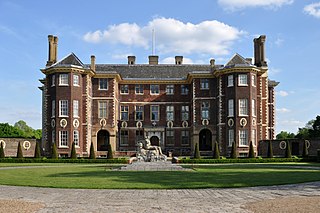
Ham House is a 17th-century house set in formal gardens on the bank of the River Thames in Ham, south of Richmond in the London Borough of Richmond upon Thames. It was completed by 1610 by Thomas Vavasour, an Elizabethan courtier and Knight Marshal to James I, but came to prominence during the 1670s as the home of Elizabeth (Murray) Maitland, the Duchess of Lauderdale and Countess of Dysart and her second husband John Maitland, the Duke of Lauderdale. The house retains many original Jacobean features and furnishings and is claimed by the National Trust to be "unique in Europe as the most complete survival of 17th century fashion and power." The house is designated on the National Heritage List for England as a Grade I listed building and has been an Accredited Museum since 2015. Its park and formal gardens are listed at Grade II* by Historic England in the Register of Historic Parks and Gardens. In 1948, the house was donated to the National Trust by Sir Lyonel Tollemache and his son Major (Cecil) Lyonel Tollemache.

Chicheley Hall, in Chicheley, Buckinghamshire, is a 17,988 square feet (1,671.1 m2) English country house built in the first quarter of the 18th century in the Baroque style.

Trentham Estate, in the village of Trentham, is a visitor attraction located on the southern fringe of the city of Stoke-on-Trent in Staffordshire, United Kingdom.

Athelhampton is a settlement and civil parish in Dorset, England, situated approximately 5 miles (8 km) east of Dorchester. It consists of a manor house and a former Church of England parish church. Dorset County Council's 2013 mid-year estimate of the population of the civil parish is 30.

Clevedon Court is a manor house on Court Hill in Clevedon, North Somerset, England, dating from the early 14th century. It is now owned by the National Trust. It is designated as a Grade I listed building.
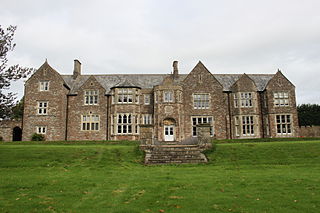
Sutton Court is an English house remodelled by Thomas Henry Wyatt in the 1850s from a manor house built in the 15th and 16th centuries around a 14th-century fortified pele tower and surrounding buildings. The house has been designated as Grade II* listed building.

Woodchester Mansion is an unfinished, Gothic revival mansion house in Woodchester Park in Woodchester, near Nympsfield, Gloucestershire, England. It is on the site of an earlier house known as Spring Park. The mansion is a Grade I listed building.
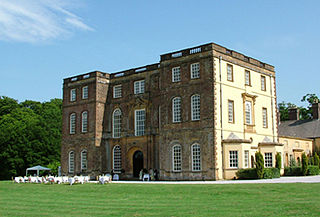
Halswell House is a Grade I listed country house in Goathurst, Somerset, England.
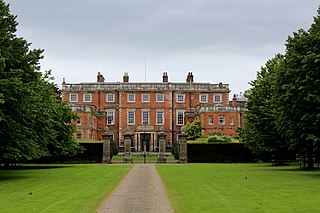
Newby Hall is a country house beside the River Ure in the parish of Skelton-on-Ure in North Yorkshire, England. It is 3 miles south-east of Ripon and 6 miles south of Topcliffe Castle, by which the manor of Newby was originally held. A Grade I listed building, the hall contains a collection of furniture and paintings and is surrounded by extensive gardens. Newby Hall is open to the public.

Nettlecombe Court and park is an old estate on the northern fringes of the Brendon Hills, within the Exmoor National Park. They are within the civil parish of Nettlecombe, named after the house, and are approximately 3.6 miles (5.8 km) from the village of Williton, in the English county of Somerset. It has been designated by English Heritage as a Grade I listed building.
Colwich is a civil parish and village in Staffordshire, England. It is situated off the A51 road, about 3 miles (5 km) north west of Rugeley, and 7 miles (11 km) south east of Stafford. It lies principally on the north east bank of the River Trent near Wolseley Bridge, just north of The Chase. The parish comprises about 2,862 hectares (28.62 km2) of land in the villages and hamlets of Colwich, Great Haywood, Little Haywood, Moreton, Bishton, and Wolseley Bridge.
There have been two baronetcies created for members of the Wolseley family, one in the Baronetage of England and one in the Baronetage of Ireland. As of 2018 the Wolseley Baronetcy of Mount Wolseley is dormant.

Tyttenhanger House is a 17th-century country mansion, now converted into commercial offices, at Tyttenhanger, near St Albans, Hertfordshire. It is a Grade I listed building.
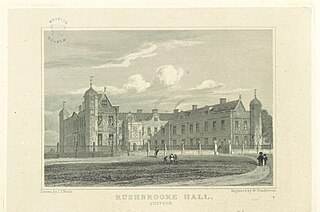
Rushbrooke Hall was a British stately home in Rushbrooke, Suffolk. For several hundred years it was the family seat of the Jermyn family. It was demolished in 1961.

The Wolseley Centre is a visitor centre and nature reserve of the Staffordshire Wildlife Trust, in Staffordshire, England, about 2 miles (3 km) north-west of Rugeley, and about 7 miles (11 km) south-east of the county town of Stafford.


















